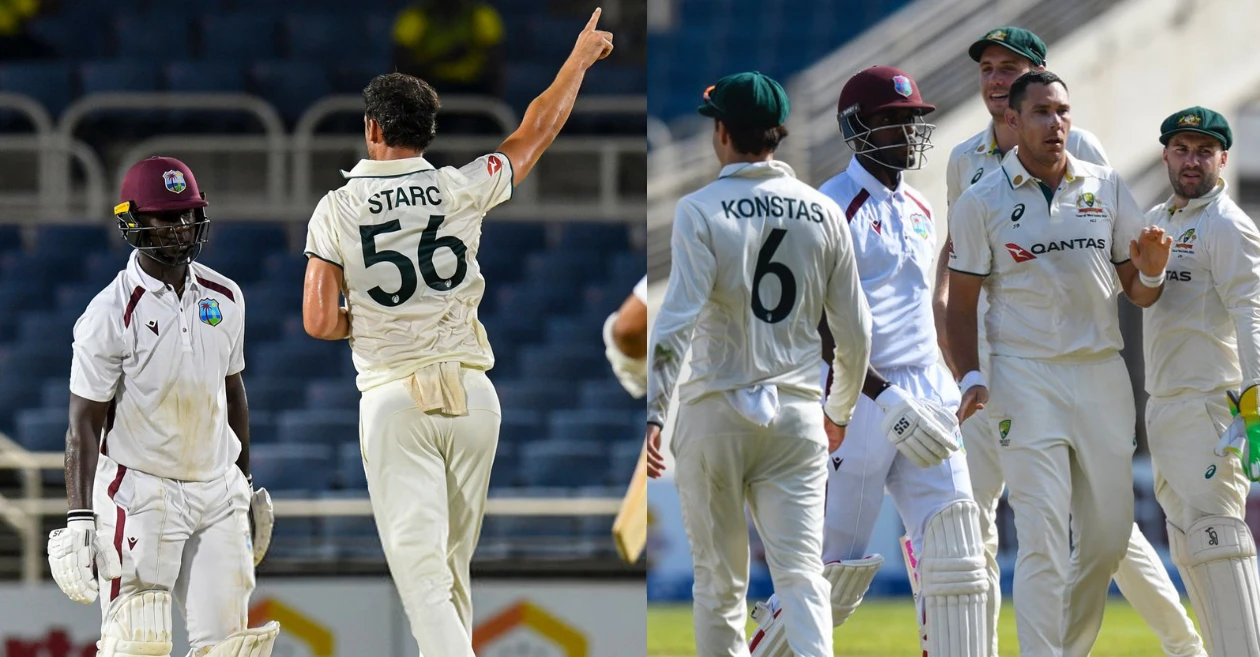Test cricket is known for its elegance, discipline, and the slow-burn thrill that unfolds over five days. It’s the pinnacle of the sport—a true test of character, skill, and mental strength. But while this traditional format has witnessed the rise of legendary centuries and heroic bowling feats, it has also delivered unforgettable collapses—moments when entire batting line-ups crumbled like houses of cards under pressure, pitch demons, or sheer bowling brilliance.
While individual brilliance often defines Test history, collective failures leave deeper scars. The lowest team totals in Tests remind us that no matter how seasoned or star-studded a side may be, no one is immune to disaster.
Let’s revisit the five lowest team innings totals in the rich, and sometimes brutal, history of Test cricket—featuring timeless records, historic venues, and a shocking 2025 West Indian collapse that has stunned the modern cricketing world.
1. New Zealand – 26 all out vs England (Auckland, 1955)
-
Date: March 25, 1955
-
Venue: Eden Park, Auckland
-
Opponent: England
To this day, New Zealand’s 26 all out stands as the lowest team total in Test cricket history. In the second Test of England’s tour, the Kiwis fell to a terrifyingly accurate English pace attack in front of a stunned Auckland crowd. The collapse came in the second innings, chasing a modest total to avoid an innings defeat.
England’s seamers, Bob Appleyard (3/7), Frank Tyson (2/10), and Trevor Bailey (4/7), made the ball talk on a green-top wicket. The conditions offered swing, and the Kiwis had no answers. What makes this innings remarkable is that not a single batter reached double digits—the top scorer was Bert Sutcliffe with 11.
The innings lasted 27 overs. New Zealand were defeated by an innings and 20 runs, and that infamous 26 has now remained unbroken for 70 years—an eternal symbol of Test cricket’s unforgiving nature.
2. West Indies – 27 all out vs Australia (Kingston, 2025)
-
Date: July 14, 2025
-
Venue: Sabina Park, Kingston
-
Opponent: Australia
The cricket world was left speechless as West Indies collapsed for 27 runs on home soil—the lowest total in their history and the second-lowest in Test history.
Chasing 204 on the final day of the third Test against Australia, the West Indies were blown away in 14.3 overs, suffering one of the swiftest and most humiliating defeats ever seen in international cricket. The rot began early and never stopped.
Veteran seamer Mitchell Starc rolled back the years with a jaw-dropping spell of 6/9, including a double-wicket maiden to start his spell. As if that wasn’t enough, Scott Boland etched his name into history with a hat-trick, dismissing Hope, Athanaze, and Blackwood in succession.
The final scorecard was chilling:
-
7 ducks in the batting line-up
-
Only one batter, Justin Greaves, reached double digits (11)
-
10 wickets fell in less than an hour
The West Indies were not just beaten—they were annihilated. The defeat gave Australia a 3-0 whitewash and broke a 148-year-old record for most ducks in a Test innings by a single team.
3. South Africa – 30 all out vs England (Port Elizabeth, 1896)
-
Date: February 13, 1896
-
Venue: St George’s Park, Port Elizabeth
-
Opponent: England
Test cricket was still in its formative years when South Africa crumbled to 30 all out in their first innings at Port Elizabeth. The pitch was dreadful, offering absurd bounce and movement, but England’s George Lohmann didn’t care.
In one of the most extraordinary individual spells ever, Lohmann claimed 8 wickets for just 7 runs. The South African batters simply couldn’t cope with his nagging accuracy and seam movement. They were dismissed in 18.4 overs.
It was a time when helmets didn’t exist, and batsmen had limited protective gear. Still, this level of collapse was catastrophic. England went on to win by 288 runs, and Lohmann’s bowling figures remain some of the most economical and devastating in Test history.
4. South Africa – 30 all out vs England (Birmingham, 1924)
-
Date: June 14, 1924
-
Venue: Edgbaston, Birmingham
-
Opponent: England
Nearly three decades later, South Africa found themselves reliving their 1896 nightmare—this time at Edgbaston.
After posting a respectable 390, England saw South Africa fold for 30 in just 12.3 overs. Arthur Gilligan (6/7) and Maurice Tate (4/12) tore through the line-up with relentless pace and precision.
No batter looked remotely comfortable. The top scorer? Bob Catterall with 10. Nine players failed to make it past five runs.
What makes this match unforgettable is not just the score, but the shocking similarity to their 1896 collapse—two innings of 30 all out, 28 years apart, both inflicted by England. A recurring trauma for South African Test history.
5. South Africa – 35 all out vs England (Cape Town, 1899)
-
Date: April 1, 1899
-
Venue: Newlands, Cape Town
-
Opponent: England
South Africa complete an unwanted hat-trick on this list with yet another miserable innings—35 all out at Newlands.
On a bowler-friendly track in Cape Town, England’s Schofield Haigh and Wilfred Rhodes shared the spoils. The hosts were bowled out in just over 22 overs, collapsing like dominoes with no one offering even fleeting resistance.
Only two batters crossed five runs. The rest were bamboozled by length, spin, and seam movement. Though this match predates many modern cricket fans, it still resonates as a lesson in the perils of fragile batting under duress.
Quick Summary of the Top 5 Lowest Innings Totals
| Rank | Team | Total | Opponent | Venue | Year |
|---|---|---|---|---|---|
| 1 | New Zealand | 26 | England | Auckland | 1955 |
| 2 | West Indies | 27 | Australia | Kingston | 2025 |
| 3 | South Africa | 30 | England | Port Elizabeth | 1896 |
| 4 | South Africa | 30 | England | Birmingham | 1924 |
| 5 | South Africa | 35 | England | Cape Town | 1899 |
Insights: What Leads to a Test Collapse?
1. World-Class Bowling Under the Right Conditions
Every collapse in this list was driven by extraordinary bowling. Whether it was Mitchell Starc in 2025 or George Lohmann in 1896, when bowlers hit their stride, even the best batters look ordinary.
2. Pitch and Weather
Often overlooked, pitch conditions are massive contributors. Uneven bounce, early moisture, or spin-friendly footmarks can play havoc with batting rhythm.
3. Mental Pressure
Chasing a target, avoiding follow-on, or battling for a draw—psychological pressure has shattered many a lineup. Once a few wickets fall, panic sets in.
4. Lack of Application and Patience
Modern cricket encourages aggression, but in Test cricket, patience is key. Many collapses stem from rash strokes, misjudgment, or failure to adapt.
Notable Mentions: Close Calls
-
India – 36 all out vs Australia (Adelaide, 2020)
-
Ireland – 38 all out vs England (Lord’s, 2019)
-
Bangladesh – 43 all out vs West Indies (North Sound, 2018)
-
Australia – 36 all out vs England (Birmingham, 1902)
Though not in the top five, these innings were equally shocking and caused major introspection in their respective cricketing nations.
A Game That Gives and Takes
Cricket, and especially Test cricket, is a game of extreme contrasts. One day you’re celebrating a triple century, the next you’re bowled out for 27. These collapses serve as chilling reminders that no score is too low, no collapse too impossible.
As the West Indies painfully learned in July 2025, Test cricket remains a cruel and magnificent arena. Records may be broken, but the scars of collapse linger long in the memory of fans and players alike.
Please check for information on the best betting sites in India – https://selectory.org/best-betting-sites/















